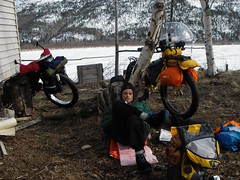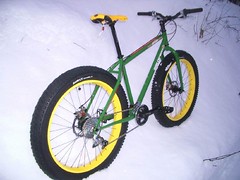Originally posted at NPR.org, December 14, 2007 Jill Homer of Juneau, Alaska, is training to ride 350 miles in the human-powered Iditarod. The race, which starts in February, follows the same route used by the famous dog sled teams.
People sometimes say, "Wow, riding a bike on snow — that's great. But how does it work?" Snow-biking can be different from regular cycling, so I've compiled a list of 10 tips for riding a bike on snow.
1. Think surface area: If you've ever used snowshoes before, you know that all that mass at the bottom of your feet can mean the difference between coasting atop power or wading knee-deep in it. Snow bikes work they same way. They incorporate wide tires with a flat profile in order to distribute bulk (you) as evenly as possible, allowing for maximum floatation.
2. Fat is the new skinny. As long as there have been bicycles, there have been weight-weenie types trying to shave grams off wheels. Nowadays, it's not uncommon to see a spoke-free wheel sporting tires as thin as razors. But once you slice into snow, skinny tires might as well be razors. Snow-bikers know that fat means float, and have been developing bicycles to accommodate increasingly larger wheels for years. I predict that not too far in the future, someone will build a bicycle frame with room for motocross tires. Look for it.
3. There is no shame in walking. Cyclists hate to admit when they come to a hill or an obstacle they just can't conquer. I have seen cyclists blow out their knees and face-plant over logs just to avoid suffering the indignity of getting off the bike and walking. Snow-bikers have no such pretensions. We know that bikes are not ready-made for snow, and vice versa. If snow is too soft, or too deep, or too wet, we simply step off and amble along until we can ride again. We learn to enjoy it, like walking a dog, but without the constant slobbering.
4. When in doubt, let air out. Often, snowy trails are what we would call "marginally ridable." By letting air out of tires, you can increase the surface area and improve your floatation. Sometimes it means riding on nearly flat tires at a pace a snail wouldn't envy, but, despite what I said in the previous paragraph, it's still better than walking.
5. Learn your snow types. It's been said that Eskimos have dozens of different words of snow. Snow bikers also understand the myriad varieties: powder, sugar, corn, hard-pack, sandy, slushy, and so on. Each type comes with its own challenges. But understanding the nature of the white stuff you are trying to ride atop, you can adjust your riding and wheels to meet the conditions.
6. Don't be disappointed when you fail to set a land-speed record. Snow, like sand, puts up a lot of resistance, and snow bikers are not known for their speed. I have often heard accounts of cyclists who said felt like they were careening down a hill, only to look down and see they hadn't even breached the 10 mph barrier. In snow races, 10 mph is considered fast. Eight mph is average. Six mph is respectable, and four mph isn't uncommon. When asked to describe the nature of the 2006 Iditarod Invitational, which was plagued by cold temperatures and fresh snow, third-place finisher Jeff Oatley said, "It was about as intense as a 2.5 mph race can be."
7. All brakes are not created equal. When contemplating what brakes to put on their bikes, cyclists have all kinds of reasons to choose between disc or rim. But snow bikers, who often find their rims coated in a thick layer of ungrippable ice, have the best reason of all: Rim brakes could mean an icy death by gravity. Go with disc.
8. Re-lubricate and be free. There is nothing that will slow down a snow biker faster than having their hubs freeze up, which is always a possibility when the mercury drops below zero. We have to lube up our moving parts with a special low-temperature grease, sold widely in cold regions like Fairbanks and Minnesota.
9. Stay away from moose tracks. Common injures for road cyclists include road rash and head injuries. Mountain bikers have problems with broken collar bones and bad knees. Alaska snow bikers are always being tripped up by the deep, narrow holes moose leave when they walk through the snow. Avoiding these minefields will help curb post-holing injuries like broken ankles.
10. Stay away from dogs. We talk a lot about fear of angry moose, grumpy bears and rabid wolves, but our most likely animal to have a dangerous encounter with remains the sled dog. They approach so quickly and quietly that we sometimes don't even have time to jump off the trail. A collision can be disastrous — imagine tangled lines, confused canines and a lot of sharp teeth. Add to that an annoyed musher who's likely packing heat, and you stir up the kind of fear that convinces snow-bikers to give those racing puppies a wide berth.
Jill Homer blogs at Up in Alaska.







































